
Recently, a published scholarly study reported findings supporting a remarkable observation about the famous megalithic pillars of a nearly 12,000-year-old Neolithic site in southern Türkiye. In that study, the author suggests that certain symbols carved onto the faces of pillars at the site were made to track time and mark the changes of seasons by recording observations of the sun, moon and stars through a lunisolar calendar system. Moreover, the study posited that the markings also record the date when comet fragments impacted the Earth almost 13,000 years ago – or 10,850 BC.
The suggestion is remarkable because, if true, it would be the oldest such calendar ever discovered. It would also add to the implication that a Neolithic group of people were astute observers of their astronomical environment and that they were able to apply this knowledge in a sophisticated way to manage and work with their environment — capabilities not thought to have been developed for another few thousand years.
This discovery, if confirmed, exemplifies the game-changing revelations that have emerged from a group of sites in present-day Turkey, illuminating our understanding of the meaning and significance of the otherwise sketchy Neolithic peoples who inhabited this part of the world thousands of years before the florescence of the great agriculturally-based civilizations such as Mesopotamia and Egypt. These new insights are opening a window on societies that provided the foundation for the development of Old World civilization. One of these sites, known as Göbekli Tepe, has captured the imagination of the world….
_______________________________
The Site
Göbekli Tepe is a prehistoric settlement inhabited from about 9500 BCE to at least 8000 BCE, during the Pre-Pottery Neolithic in the Southeastern Region of ancient Anatolia (modern day Türkiye). Most notable at this site are the large circular structures or enclosures that contain massive carved and shaped megaliths featuring carved anthropomorphic figures, clothing, and wild animals. These finds have been the subject of interpretation by archaeologists regarding the iconography and religious beliefs of the mysterious prehistoric people who inhabited and visited the site. The site also features a rich representation of domestic structures, other small buildings, cisterns, and quarries. Although the site’s original excavator, Klaus Schmidt, interpreted the site as a religious sanctuary established and visited by hunter-gatherers, more recent findings of domestic structures, the cisterns and evidence of water management, as well as tools associated with domestic activity, point to a relatively permanent, continuously inhabited settlement.
_________________________

Map showing location of Göbekli Tepe. Public Domain, Wikimedia Commons
_________________________
Research History
Long before archaeological work began on the site, the rocky hill on which it is located was considered by local tradition to be a sacred place, although it was also under agricultural cultivation. Archaeologically speaking, the site was originally identified through a survey conducted by the Istanbul University and the University of Chicago in 1963.
It was not until October 1994 when German archaeologist Klaus Schmidt, having already worked at the site of Nevalı Çori, another ancient site in the area, began searching for other ancient sites, including the site identified by the survey in 1963. The Yıldız family, who owned the land where the site was located, directed him to the site. They had previously discovered finds (reported to the local museum) while ploughing. Schmidt recognized the finds as similar to those of Nevalı Çori, suggesting they were fragments of prehistoric megaliths. The following year he began official excavations, uncovering the first of the now-famous T-shaped pillars.
Schmidt directed ongoing excavations at Göbekli Tepe under the auspices of the Şanlıurfa Museum and the German Archaeological Institute (DAI) until he died in 2014. The DAI has continued at the site under the direction of Lee Clare and since 2021 work has been a joint operation of Istanbul University, the Şanlıurfa Museum, and the DAI, under the direction of Necmi Karul.
Although it appears to the casual visitor that much of the site has been excavated, what we know from surveys incicate that less than 5% of the site had been excavated as of 2021. There is therefore much more to be revealed about Göbekli Tepe.
Excavation Results
Structural Remains
The earliest of the structures that have been excavated thus far indicate that they were built between 9500 and 9000 BCE, based on radiocarbon dating. Evidence suggests the site was greatly expanded during the early 9th millennium BCE. The settlement shows activity until about 8000 BCE. Excavation and research have revealed eight phases of development spanning at least 1,500 years.
The major structural finds were defined by large circular enclosures or compounds, the earliest of which date to the second half of the 10th millennium BCE. Floors of the enclosures were made of burnt lime or simply left as bedrock. Their most prominent characteristic features massive T-shaped limestone pillars, some standing over five meters tall and weighing several tons, spaced evenly apart within surrounding stone walls. massive Two taller pillars were placed in the center of each circle. The pillars are considered to be the oldest known megaliths in the world. The enclosures also featured benches defining their interior perimeters, thought to have been designed for sitting. It is not known if the enclosures were roofed. Although four of these enclosures have thus far been excavated, surveys suggest the presence of 16 more, each containing eight possibly similar pillars. Investigation of the site indicates that the material for the pillars were transported as slabs from a point about 100 meters (330 feet) away from the site. After their transfer, they were worked with flint tools to create the carved features we see on them today.
Although the carved decorations on the pillars remain largely enigmatic, most of them appear to be symbolically abstract pictograms and animal reliefs. Archaeologists theorize that the pictograms represent sacred symbols, similar to what have been found as Neolithic cave paintings in other locations. The animal reliefs have been interpreted to include boars, foxes, donkeys, gazelle, bulls, birds — most prominently vultures — snakes, other reptiles, insects and arachnids. Some pillars feature human arm symbols and others appear to show loincloths. One recent study and analysis of a pillar suggests that its markings may represent the world’s oldest solar calendar, and even posits that it was created as a memorial to a comet strike.
Also uncovered were small carved stones, depicting mostly animals, and some humans.
Later-dated enclosures, in contrast to the earliest enclosures, were rectangular in shape, though they continued to feature T-shaped pillars, with several tall pillars occupying the centers of the rooms. One of the enclosures has been designated the “lion pillar building” because of a pair of central pillars that featured carved, fierce lions.
_____________________________
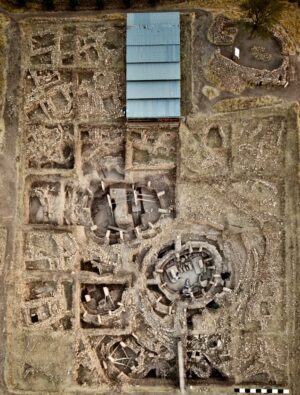
The archaeological site of Göbekli Tepe: main excavation area with four monumental circular buildings and adjacent rectangular buildings (German Archaeological Institute, photo E. Kücük). Text and image CC BY 4.0, Wikimedia Commons
_____________________________
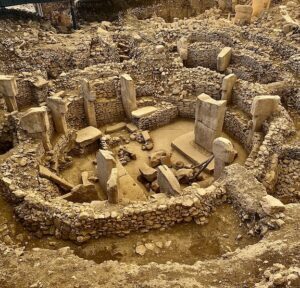
Göbekli Tepe circular enclosure with monumental pillars. TaylanOzgurUksal, CC BY-SA 4.0, Wikimedia Commons
_____________________________

Broad view of central excavation. Radosław Botev, CC BY 3.0 PL, Wikimedia Commons
_____________________________
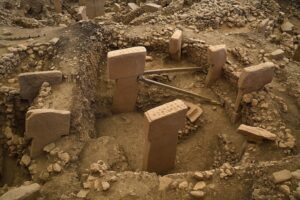
Above and below: Details of Building B, located in the Southeast-Hollow (Main Excavation Area) of Göbekli Tepe.
It has a round ground plan and measures roughly 10 metres in diameter. A total of seven T-shaped limestone pillars have so far been discovered set into its circular wall. The two central T-pillars brings the total number of monoliths in this building to nine. However, as the building is not yet excavated in its entirety, further pillars may still be found. The floor of the building was excavated over several square metres in the area between the two central pillars. The floor of this building is made of a lime mortar (terrazzo floor). The inner-facing broad sides of the two central pillars carry depictions of life-size foxes (in low relief). It dates from the 10th-9th mill. BC. Dosseman, Image and text CC BY-SA 4.0, Wikimedia Commons
_____________________________

_____________________________
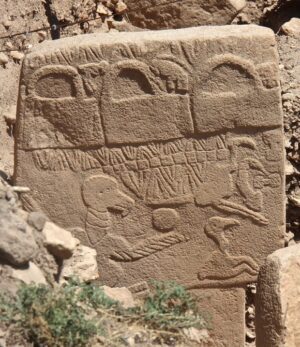
Vulture Stone, Gobekli Tepe. The Vulture Stone is thought to be the world’s first pictograph. It depicts a human head in the wing of a vulture and a headless human body under the stela. There are various figures like cranes and scorpions around this figure. Sue Fleckney, Image and text CC BY-SA 4.0, Wikimedia Commons
_____________________________

Above and below: Animal stones uncovered at the site. Dosseman, CC BY-SA 4.0, Wikimedia Commons
_____________________________
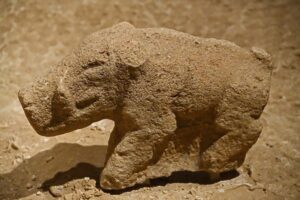
_____________________________

_____________________________
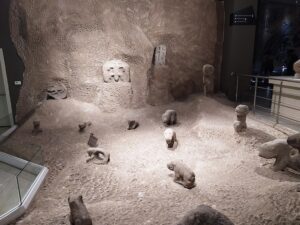
Göbekli Tepe animal statuettes, Şanlıurfa Museum, Turkey. Radosław Botev, CC BY 3.0 PL, Wikimedia Commons
_____________________________
Stone Tools
Excavations at Göbekli Tepe have yielded a prolific assemblage of flint artifacts, most of which are similar to artifacts found at other sites in the northern Levant dated to the Pre-Pottery Neolithic.
In the first year of full excavation alone (1963) more than 3,000 stone tools were discovered, mostly made of flint but a few from obsidian. The assemblage consisted of a variety of tool types, including cores, flakes, choppers, blades, burins, scrapers, and projectile points, offering insights on the human activities at the site.
Of particular note are the results of excavations in a part of the site designated as Space 16, identified as a building construction near enclosure D. This space yielded nearly 700 tool artifacts, consisting of scrapers, glossy objects, perforators, and many retouched tools.
Significant to the activity of food production and processing, more than 7000 grinding stones were recovered across the site. Evidence from phytoliths found in the associated soil suggests that the grinding stones were used to process cereal grains. Archaeologists have yet to affirmatively conclude that the cereals were wild or cultivated.
What excavations have revealed about the evolution of the site
_____________________________
You can read the rest of this article by subscribing to Popular Archaeology.
Cover Image, Top Left: TaylanOzgurUksal, CC BY-SA 4.0, Wikimedia Commons
_____________________________
Advertisement

EXPLORE THE ANCIENT ETRUSCANS IN PERSON!
Experience a unique, up-close-and-personal hike among ancient hilltop towns in central Italy. You will walk the sensational countryside of the regions of Umbria and Tuscany, soaking in important sites attesting to the advanced Etruscan civilization, forerunners of the ancient Romans; imposing architectural and cultural remains of Medieval Italy; local food and drink; and perhaps best of all — spectacular scenic views! Join us in this collaborative event for the trip of a lifetime!


